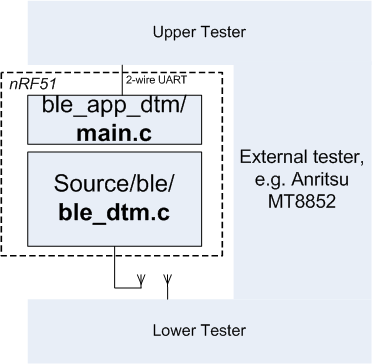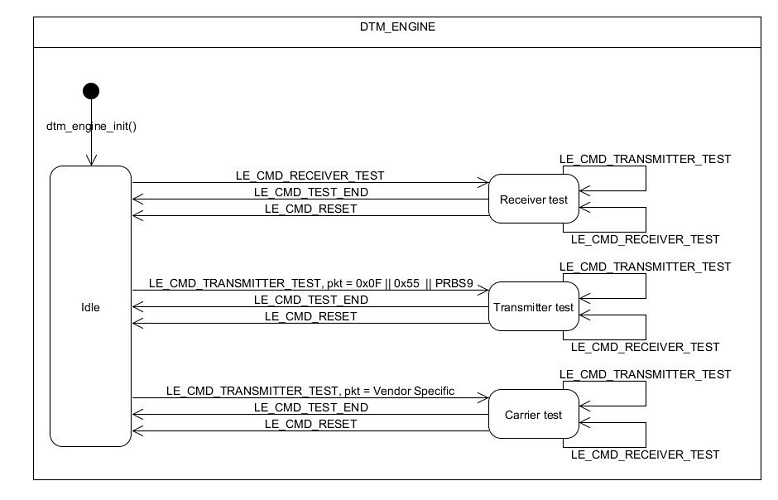The DTM application enables the DTM test functions described in Bluetooth Specification Version 4.0, Vol. 6, Part F.
The purpose of DTM is to test the operation of the radio at the physical level, such as:
- transmission power and receiver sensitivity
- frequency offset and drift
- modulation characteristics
- packet error rate
- intermodulation performance
Test procedures are defined the document "Bluetooth Low Energy RF PHY Test Specification", Document no RF-PHY.TS/4.0.0. Conformance tests are carried out by dedicated test equipment (such as the Anritsu MT8852 or similar), the nRF51 with the DTM application as the DUT.
The nRF51 DTM application includes two parts:
- DTM - Direct Test Mode library, which manages the nRF radio and controls the standard DTM procedures
- an application providing an external interface to the library
The DTM application contains a driver for a 2-wire UART interface, mapping two-octet commands and events as specified by the BLE DTM specification to the dtmlib.
The name of the example is direct_test_mode_sXXX_pca10028, where XXX is the number of the SoftDevice that you are using. If you are not using the Keil Pack Installer, you can find the source code and project file of the example in the following folder: <InstallFolder>\examples\dtm\direct_test_mode
Source code and project file for the ble_dtm module can be found in the following folder: <InstallFolder>\components\ble\ble_dtm

The implementation is self-contained and requires no BLE protocol stack for its operation. The MPU is initialized in the standard way (files startup_nRF51502.s and system_nRF51502.c. The dtmlib function dtm_init() will do all configuration of interrupts, timers and radio. Initialization of the UART is done by the dtm_serial2w code.
main.c may be replaced with other interface implementations, such as an HCI interface, USB, or other interface required by the Upper Tester.
The interface to the Lower Tester uses the antenna connector of the nRF51. While in principle an aerial may be used, conformance tests cover reading the transmission power delivered by the DUT; hence a coax connection between the DUT and the Lower Tester is employed for all conformance testing.
BLE DTM module interface
ble_dtm.c function dtm_cmd() implements the four commands defined by the BLE standard
- RESET
- RECEIVER_TEST
- TRANSMITTER_TEST
- TEST_END
In the dtm_cmd() interface, each of the parameters (cmd,freq, length, payload) is a word size value. Note that the currently supported parameter values are limited to those defined for BLE. (HCI allows a greater value range for use with BR/EDR.)
The following DTM events are polled using the dtm_event_get() function:
- PACKET_REPORTING_EVENT
- TEST_STATUS_EVENT [SUCCESS|FAIL]

Vendor Specific Packet Payload
The BLE 2-wire UART DTM interface standard reserves Packet Type (payload parameter) binary value '11' for a Vendor Specific Packet Payload. The dtm_serial2w adaptation layer maps this to value 0xFFF..FFF in the dtm_cmd() interface. The rationale for this mapping is to allow later extensions to a 4-bit Packet Type field, as specified in the HCI interface and in the DTM PDU layout.
The Vendor Specific payload (parameter 4) is interpreted as follows:
If Command, parameter 1, is set to Transmitter Test (binary '10') and parameter 4, payload, to Vendor Specific (binary '11' in the 2wire physical interface, all bits set to 1 in the dtmlib interface):
- If parameter 3 (length) is set to 0 (symbol CARRIER_TEST), an unmodulated carrier is turned on at the channel indicated by parameter 2 (freq). It remains turned on until a TEST_END or RESET command is issued.
- Parameter 3 (length) equal to 1 (symbol CARRIER_TEST_STUDIO) is used by the nRFgo studio to indicate an unmodulated carrier is turned on at the channel. It remains turned on until a TEST_END or RESET command is issued.
- If parameter 3 (length) is set to 2 (symbol SET_TX_POWER), parameter 2 (length) sets the tx power in dBm, ranging from -40 to +4 in steps of 4, 0 dBm being the reset value. The tx power can only be modified while no Transmitter Test or Receiver Test is running.
- If parameter 3 (freq) is set to 3 (symbol SELECT_TIMER), parameter 2 (length) selects the timer to be used by dtmlib for Transmitter Test timing. Valid timer identifiers are 0, 1 and 2. Configuring the timer to be used allows dtmlib to be integrated in a larger test environment where other modules may be occupying the default timer (timer 0).
- All other values of parameter 2 (freq) and 4 (length) are reserved.
The DTM to Serial adaptation layer
main.c is a sample adaptation layer, implementing the UART interface as specified in Volume 6, part F, chapter 3 of the Bluetooth specification.
The default selection of GPIO pins are pin 11 for RX and pin 9 for TX. These defaults are defined in <InstallFolder>\examples\bsp\pca10028.h and can be changed by editing the values of the symbols RX_PIN_NUMBER and TX_PIN_NUMBER.
Running DTM tests
Conformance testing is done using a certified tester. The setup depends on the actual tester, and details about the test operation must be found from the tester documentation.
The BLE DTM UART interface standard specifies:
- 8 data bits
- No parity
- 1 stop bit
- CTS/RTS Flow control
- A selection of bit rates from 1200 to 115200, one of which must be supported by the DUT
The default bit rate of the DTM UART driver is 19200 bps, which is supported by most certified testers.